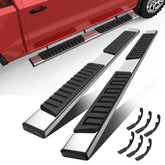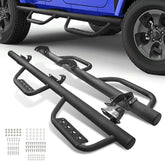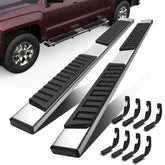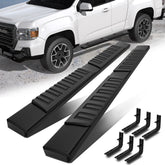Do Running Boards Affect Gas Mileage?
Have you ever wondered if those sleek running boards installed on your vehicle affect its gas mileage? The debate over automotive accessories and their impact on fuel efficiency is a topic of interest for many drivers. Running boards, famous for their utility and aesthetic appeal, often raise questions about their influence on a vehicle's overall fuel consumption. To delve into this matter, we must consider various factors affecting gas mileage when adding these accessories to a car.
Aerodynamic Challenges of Running Boards
Running boards, while offering practical benefits such as easier vehicle access and added exterior styling, introduce aerodynamic complexities that can impact fuel consumption. These accessories alter the airflow around the vehicle, potentially increasing drag and disrupting the smooth flow of air over and under the vehicle's body.
Here are some critical aerodynamic challenges associated with running boards:
1. Increased Drag Coefficient
Running boards can disrupt the smooth airflow around the vehicle, leading to an increase in drag. Drag is the resistance the vehicle encounters as it moves through the air. Increased drag coefficient due to running boards can decrease fuel efficiency, especially at higher speeds.
2. Turbulent Airflow
Running boards can cause turbulent airflow along the sides of the vehicle. Turbulence occurs when the airflow becomes irregular and chaotic, leading to increased resistance. Turbulent airflow can create additional drag and affect the overall stability and handling of the vehicle.
3. Negative Impact on Vehicle Performance
Due to the increased aerodynamic resistance, vehicles equipped with running boards may feel less responsive or agile.
4. Noise Generation
Running boards can generate additional wind noise, especially at higher speeds. Excessive wind noise can reduce driving comfort and contribute to overall cabin noise levels.
5. Effect on Vehicle Design
Vehicle designers must account for the aerodynamic implications of running boards during the design and development process.
Running boards may require specific design adjustments to minimize their impact on aerodynamic efficiency without compromising functionality and aesthetics.
6. Fuel Efficiency Concerns
The increased drag caused by running boards can decrease fuel efficiency, particularly during highway driving, where aerodynamic efficiency is critical.

The Mechanics of Aerodynamics: Optimizing Fuel Efficiency
Efficient aerodynamic design reduces drag by shaping the vehicle to allow air to flow around it with minimal disturbance. Any appendages like running boards can disrupt this airflow pattern, leading to increased drag and fuel consumption.
Optimizing fuel efficiency through aerodynamic design involves streamlining the vehicle's contours to reduce resistance. The presence of running boards alters these contours, potentially compromising the vehicle's aerodynamic efficiency.
Analyzing Running Board Varieties: The Impact of Design
Not all running boards are created equal when it comes to aerodynamic impact. Various design factors can influence how much drag a running board creates. For instance, the running board's width, length, and shape play crucial roles in determining its aerodynamic profile.
Narrower and more streamlined running boards are likely to cause less airflow disturbance than wider, bulkier ones. The positioning of the running boards concerning the vehicle's body and wheels can affect aerodynamic performance.

Design Elements: Impact and Functionality
Beyond width and shape, other design elements, such as surface texture and edge profiles, can also influence aerodynamics. Smooth, rounded edges are generally more aerodynamically favorable than sharp, angular ones, as they help air flow more smoothly along the vehicle's sides.
Integrated running boards that blend seamlessly with the vehicle's bodylines are less likely to create aerodynamic disruptions than aftermarket add-ons.
Material: Weight and Durability
The choice of material for running boards also affects their aerodynamic performance. Heavy materials like steel add more weight to the vehicle, potentially increasing fuel consumption. In contrast, lightweight materials such as aluminum or composite plastics can mitigate this impact.
Aerodynamics Analysis: Truth versus Hypothesis
While theoretical considerations suggest that running boards can increase aerodynamic drag and reduce fuel efficiency, the real-world impact can vary. Factors such as vehicle speed, driving conditions, and overall vehicle design interact with running board characteristics to determine their effect on gas mileage.
Empirical studies and aerodynamic testing can provide valuable insights into the specific impact of running boards on fuel efficiency. Researchers can quantify the aerodynamic consequences of various running board designs by measuring drag coefficients and conducting wind tunnel tests.
Different types of running board Aerodynamics Table
|
Running Board Type |
Design Features |
Aerodynamic Impact |
|
Integrated OEM |
Streamlined |
Low |
|
Aftermarket Add-on |
Wide, Bulky |
High |
|
Aluminum |
Lightweight |
Moderate |
|
Steel |
Heavy |
High |
|
Composite Plastic |
Durable, Lightweight |
Moderate |

Conclusion
Running boards do indeed have the potential to affect gas mileage by introducing aerodynamic challenges. The key lies in balancing the functional benefits of running boards with their aerodynamic drawbacks. Manufacturers and consumers must consider design elements, materials, and aerodynamic principles to optimize vehicle performance and fuel efficiency. Further research and innovation in automotive aerodynamics can lead to the development of running boards that minimize drag without compromising usability, ultimately benefiting both drivers and the environment.
Featured Products
- $198.99
- $198.99
- Unit price
- / per
- $198.99
- $198.99
- Unit price
- / per
- $203.99
$203.39- $203.99
- Unit price
- / per
- $198.99
- $198.99
- Unit price
- / per














